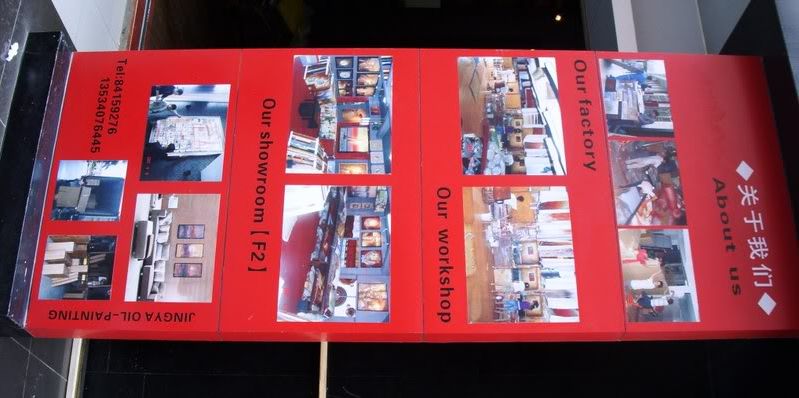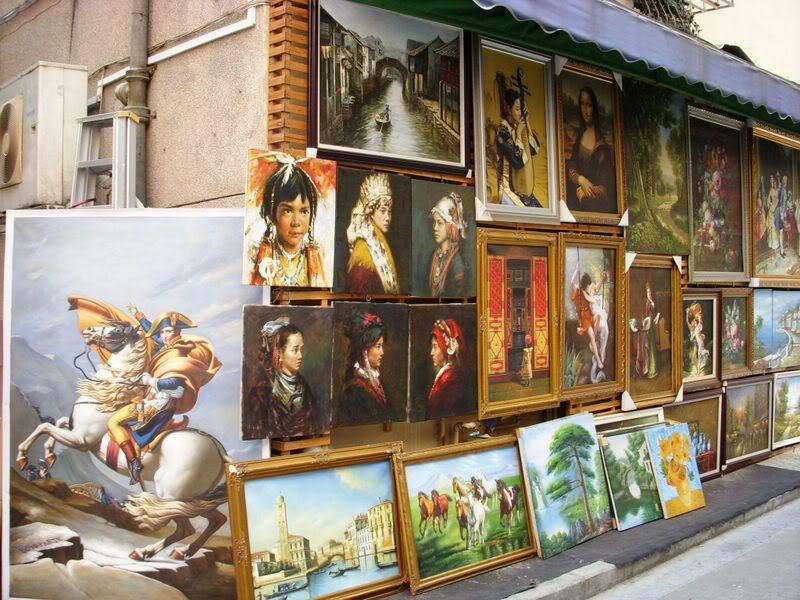technology + public space + ‘hacktivism‘ = Graffiti Research Lab
the work of art in the age of the sweatshop and the software engineer
I will admit, sheepishly, that my first impression was ‘Oh my, I would love to buy one of those,’ when I started reading about the oil paintings produced in Dafen, China. The little village, located in the south east of china, has been getting a lot of attention for producing 60% of the world’s market of reproductions of famous paintings (see Chicago Tribune and Der Spiegel). The Atlantic has some incredible pictures. This area has hundreds of factories where artists spend their days slaving away at di Vincis, O’Keefes, Klimts, Manets, and Yue Minjuns, shipping out $120 million worth of art last year alone. What this says about aura will surely be a topic in class on Tuesday. The aura of the sweatshop? I can just imagine my own instinct played out: “Oh, and over here we have our Mona Lisa… That’s right, it is a copy, made in a real Chinese sweatshop!” This is from a conversation with an 18 year old factory worker in the Trib article:
“We divide up the colors among us,” said Zeng, working his way briskly along a line of 10 identical contemporary-style paintings, applying a stripe of brown, while a teenage partner worked on the red. Surrounded by dozens more identical pieces at the sprawling Artlover factory, he explained: “By dividing up the work, contrasting colors stay clearest.”
The Trib article goes on to talk about how they have 5,000 artists, 700 galleries, and a new museum under construction. Will the latter be a mixture of copies of famous works and originals by the copyists? (Mt. Holyoke’s Ajay Sinha has apparenty given talks about the 200 history of the Chinese producing mass art for the West.) Pics from The Atlantic:


I wrote earlier about ‘Sock City,’ and this is a topic that spans both my Media and Technology class and my urban one. There’s also a professor of management science at Instead that has written a program that ‘writes’/’auto-assembles’ books (e.g., ‘The Official Patient’s Sourcebook on Acne Rosacea’ and ‘The 2007-2012 Outlook for Tufted Washable Scatter Rugs, Bathmats and Sets That Measure 6-Feet by 9-Feet or Smaller in India’) using relevant information from the public domain. Phillip Parker and his team of software engineers have written 200,000 books. (The above two books sell for $24.95 and $495, respectively.)

“ts’i mahnu” @ SXSW #2
Ok. I’m no longer at SXSW, but here’s one more pic to explicate another scene. It has the free barbecue (yes, it is so hard to abide by by new rule not eat mass-produced meat when there was so much free BBQ… it’s a plate of potato salad and beans) in the foreground from the VIP section of the Austinist/Gothamist show, to the right is the free beer (Lone Star only… I guess I prefer Shiner), and then in front of the white tent are a few photographers who are taking shots of We Barbarians. The crowd sticks to the shade until the headlining bands, so it looks like no one is there. In the background is a new condo project that hadn’t broken ground when I was standing on the same balcony last year. The Austin music ghetto has dozens of venues stuck between bail bonds and sheet metal shops. But it is quite the bourgeois bohemia. Soon enough, a local Whole Foods will move in.
I also got to check out Liam Finn (yes, son of ‘Crowded House’) and the Shout Out Louds at the show. I was set to work the door of the VIP at the event, which would have really been a nice moment of participant-observation: the ethnographer becomes gatekeeper! But the fine Austinist folks wanted to spare me what they would’ve thought to be ‘work.’ Alas.
“ts’i mahnu” @ SXSW
So, the ‘Dell Lounge and Paste Magazine‘ party has these two ‘blogger cages’ for people to report ‘live’ while at South By Southwest Music Festival. So… Here I am, checking out a band I used to like, The Weakerthans, and a brilliant musician, Kaki King. John Samson, singer from the Weakerthans, provides this banter from stage:
Is someone blogging right now? I will never get used to this modern world… This just makes me want to smash my laptop. No offense.
Um. Ok. Here’s a picture from the venue (‘Volume’). The hanging computer is one of three that allows people to surf the internet while only being mildly distracted by that band down in front. Definitely a new way to think about experiencing live music. It’s just like watching TV at home!
Later, She & Him and Billy Bragg, if I’m lucky. Ok. Off to more corporate sponsorship!
spatial segregation, maps
I think I’ve said this somewhere before, but when I saw John Edwards speak at Hunter College two years ago, I was very impressed with how he had developed his ‘Two Americas‘ meme into a story about spatial segregation. Perhaps I’m jaded, but it was refreshing to hear a politician speak on this.
Last week we watched part of Spike Lee’s documentary When the Levees Broke and discussed it alongside the first few chapters of Philippe Bourgois’ In Search of Respect to talk about issues of politics, culture, race, and space. Space is a rarely discussed issue in sociology, save for a few ethnographies (Dave Grazian speaks of this gap in his fabulous Blue Chicago)
One sociologist at the forefront of these concerns (and not an ethnographer) is John Logan, who has provided a report (pdf) on Katrina as a social disaster. Here’s a image from it:
I’m always fascinated by memory maps, and one of the lovely (and distracting) things about the InterGoogle is that there are wonders that are just a few clicks away. I have no idea how I reached this point, but there is a great Flickr collection of memory maps which are, at times amusing. There are others that highlight notions of spatial inequality. Here’s Ithaca, NY. Here’s London:
By the way, if you are an educator, HBO films provides education packs for free. Check out ‘Teaching The Levees,’ a collaboration between Teacher’s College and HBO. I suggested that we have a ‘Sociology 101 Movie Night’ to get the three 101’s using the same films (out of class) to energize class discussion… Pretty cool. It’ll be interesting to see if we can organize it.
Update, from Boing Boing:
art worlds, caught on tape
Artist Jill Miller trained herself as a licensed private investigator to then do undercover surveillance of the everyday lives of private art collectors. Odd, but true. I like how, in her description of the project, she “estimates she did surveillance on ten houses, focusing on five in depth.” Um, ‘estimates’ ten? I question her competency already. For something a little more scientific, check out Howie Becker’s Art Worlds. He has a smashing website as well, filled with many of his more interesting essays. I am fond of the ones on Calvino and Perec. Why wouldn’t I be pleased when a sociologist uses two of my top books of all time, Invisible Cities and Life, A User’s Manual? And he includes a link about my hometown of Buffalo. What more could a man want? I’ve been thinking a lot about Calvino’s book (check out the old cover, the nautilus shell and, are those mirrorballs?) in relation to my walking tour guide project since it circles around Marco Polo’s storytelling to Kublai Khan of all the cities he’s been to. In the book one starts to wonder whether or not all of these ‘cities with eyes,’ ‘continuous cities,’ ‘thin cities,’ aren’t all just Polo’s hometown of Venice told and retold again.
urban ethnographers imprisoned in berlin
Studying urban life in Berlin was one of the formative experiences of my graduate career, and working with Hartmut Häussermann deeply influenced by research, both for my dissertation and my current project on festivals. (It was, in fact his term ‘festivalization’ that got me thinking about the ways in which festivals work as de facto urban cultural policy.)
This is, of course, minor in relation to what got me thinking about him recently: one of his students has been arrested and placed into solitary confinement for supposed membership in a terrorist group. The crux of the argument against him appears to be (or so we were briefed at the ASA by Neil Brenner) that his research on gentrification mimics the writings of the terrorist group. He uses “key words and phrases” of the group and has “access” to university libraries is a part of it as well. Thankfully, a group of fellow urbanists have made the press aware of it. Sign a petition here.




